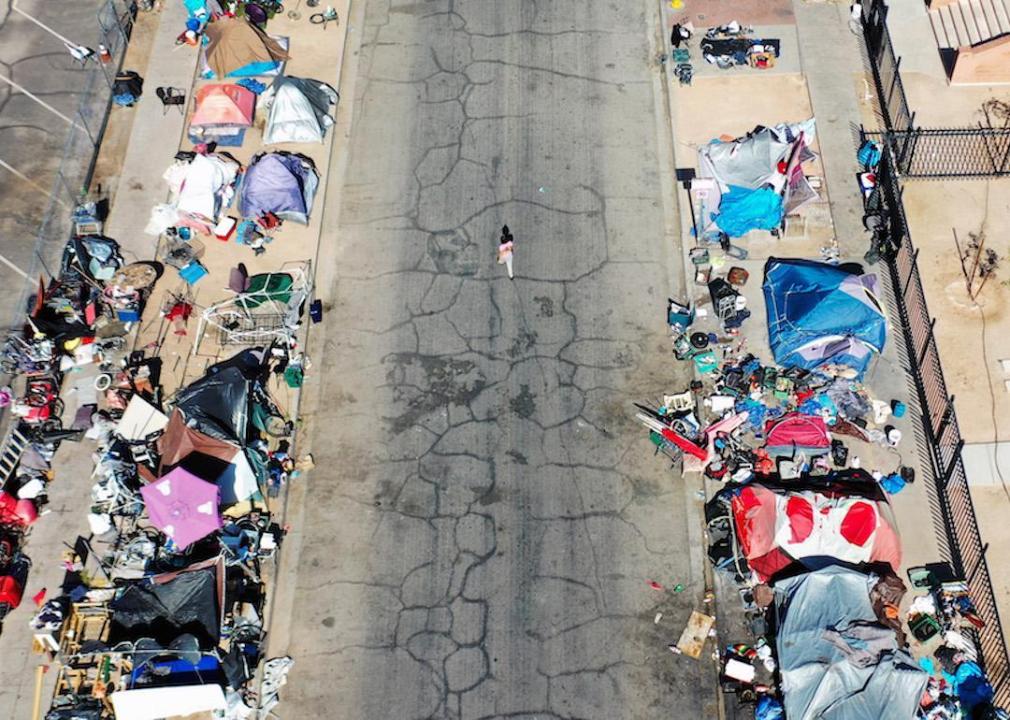
Mario Tama // Getty Images
States that recorded the biggest increase in homelessness last year
On April 22, 2024, the Supreme Court heard its biggest case related to homelessness in more than 50 years. The case started in Grants Pass, a small city in Oregon, and it could have major implications for people without housing across the U.S., potentially making it permissible to fine or jail people for camping in public. A judgment should arrive before June 30, 2024.
The homelessness crisis in the U.S. peaked in 2023, when rates rose by 12% compared to 2022, according to Department of Housing and Urban Development data. The numbers were the highest on record since similar reporting began 16 years prior. Counter to the overwhelming trend toward increased rates of homelessness, in nine states, levels of homelessness decreased from the year before, with Delaware and Louisiana recording the most significant drops. While the COVID-19 pandemic took an immense toll on the lives of most Americans, for those already experiencing homelessness or housing and economic insecurity, the challenges presented by the public health crisis were nearly impossible to escape. For unhoused people, emergency shelters, which once promised at least temporary refuge from the elements, became sources of danger as crowded spaces transformed into infection centers.
In major cities, in particular, already-limited shelters began further reducing their capacity as COVID-19 transmission among residents soared. Roughly 613 unhoused New Yorkers died between July 2019 and June 2020, an increase of 52% from the year before. In San Francisco, the number of deaths of people experiencing homelessness more than doubled from March 2020 to March 2021.
While these chilling numbers might have predicted a spike in unhoused people in shelters in 2021, national- and state-level data tell a somewhat different story. The overall number of sheltered unhoused people—people staying in emergency shelters, transitional housing programs, or safe havens—decreased across the country by nearly 8%, according to HUD data. Possible reasons for the drop vary, including robust government interventions like stimulus payments, unemployment benefits, the eviction moratorium, and other factors like unhoused people avoiding shelters due to health risks.
The eviction moratorium ended in November 2021 after the Supreme Court struck down the measure. As evictions began and rents skyrocketed, homelessness rose to record levels. Today, the issue of homelessness remains an urgent crisis, according to HUD Secretary Marcia L. Fudge.
Fourteen states recorded an increase in their sheltered homeless population. The root causes of homelessness persist, and the pandemic exacerbated many. No state has an appropriate supply of affordable housing available for the lowest-income renters—the estimated national deficit is 7 million homes. And unhoused people in rural areas can face what is known as service deserts, where a lack of shelters and housing assistance creates even more hardship.
To better understand what's behind the increase in sheltered homelessness in 14 states, Stacker examined data from HUD's annual Homeless Assessment Report and tracked how homelessness rates changed from 2022 to 2023, the latest data available. States that recorded an increase in sheltered homelessness were placed in order of smallest to largest percentage increase.
You may also like: Indigenous data warriors and the ongoing fight for data sovereignty
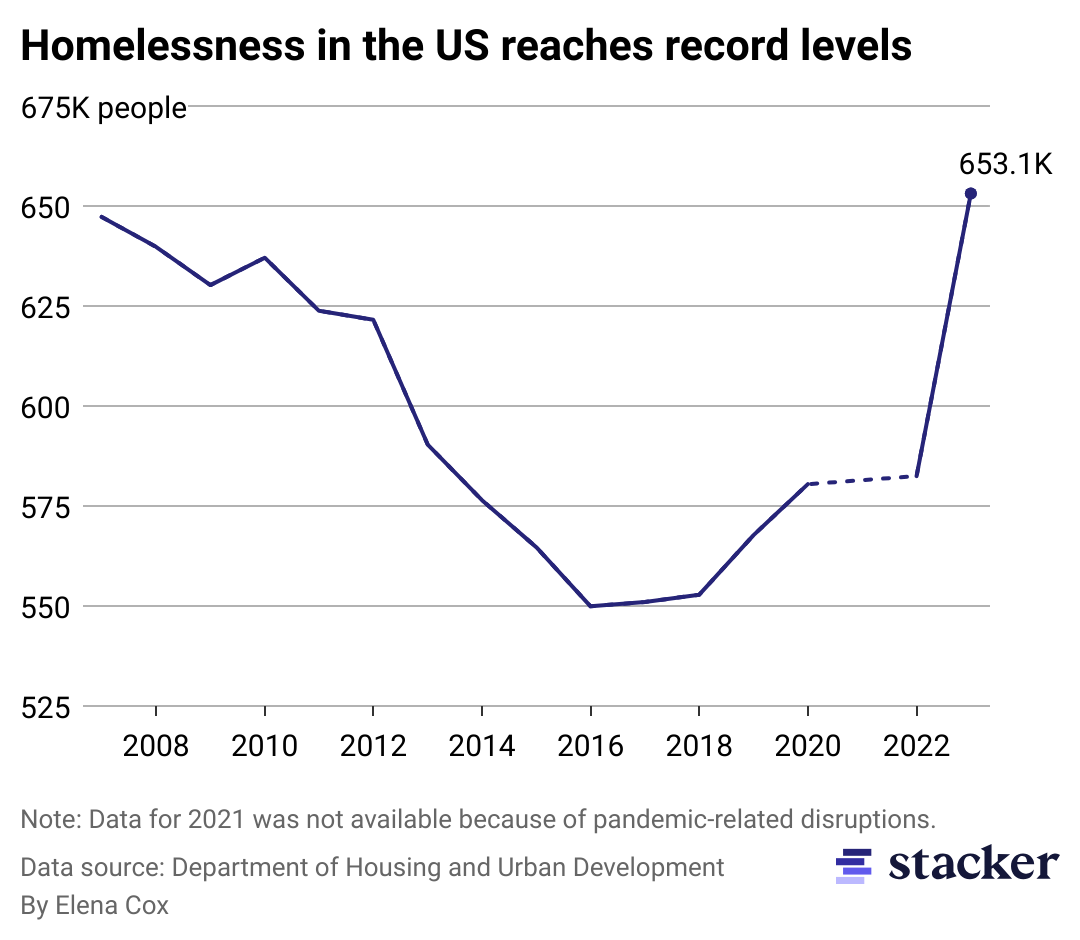
Stacker
How the homeless population has changed since 2007
According to the National Low Income Housing Coalition, the capacity of homelessness assistance services like permanent supportive housing beds and shelter beds increased between 2007 and 2015. Strategic funding from HUD and resources from other agencies helped to decrease the number of sheltered, unhoused people over the past decade.
The onset of the pandemic had mixed effects on rates of homelessness in the U.S. Increased economic instability and the risk of infection disproportionately impacted unhoused people, yet COVID-19 relief funding enabled the expansion of certain services, which allowed better assistance to the most vulnerable populations.
As NPR reports, however, these numbers shifted in 2023 when that funding ran out, inflation spiked, and so did rent prices, which have historically had a direct correlation to homelessness rates.
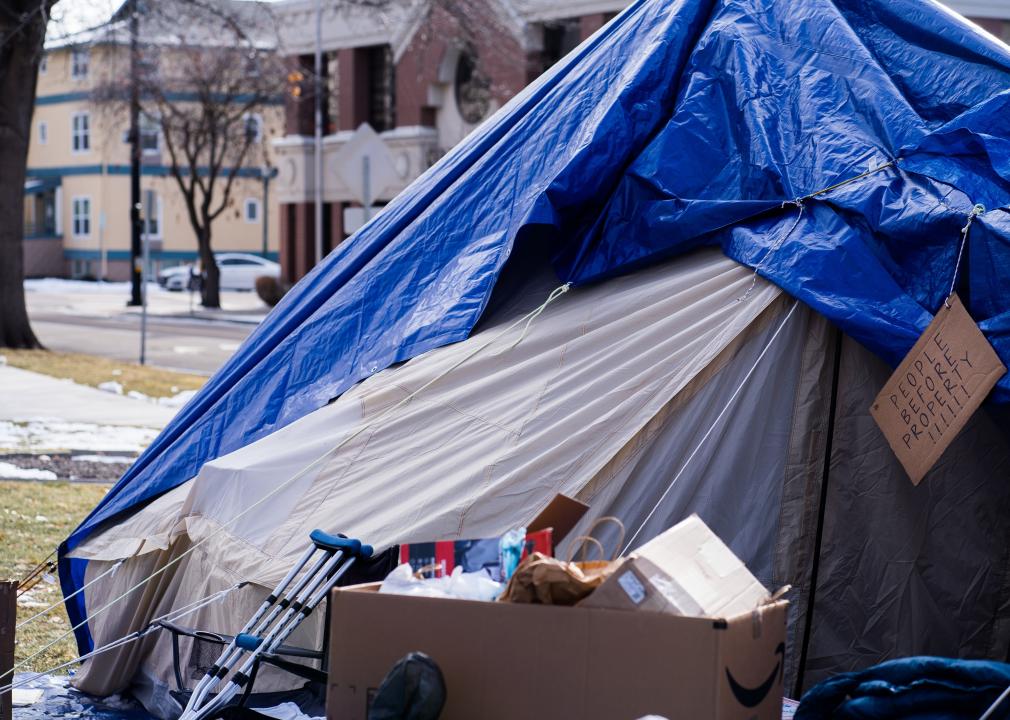
Venture Out Media // Shutterstock
#14. Idaho (tie)
- Estimated number of people experiencing homelessness in 2023: 2,298
- Increase since 2022: 15%
One of the primary culprits behind the rise of homelessness in Idaho over the past years is the increase in cost of living, combined with stagnant wages. The Idaho Press reported that a lack of affordable housing in Treasure Valley, home to the Boise metro area, has contributed to more than 300 families experiencing homelessness for the first time in 2023. Rents have increased by roughly 40% since 2019, but wages have not kept pace.
As of 2022, Idaho is short 21,214 rental homes that are affordable and available to extremely low-income renters, according to the National Low Income Housing Coalition. Beyond the lack of affordable housing, the leading cause of family homelessness in the state is domestic violence, according to CATCH, an Idaho-based housing-first nonprofit.
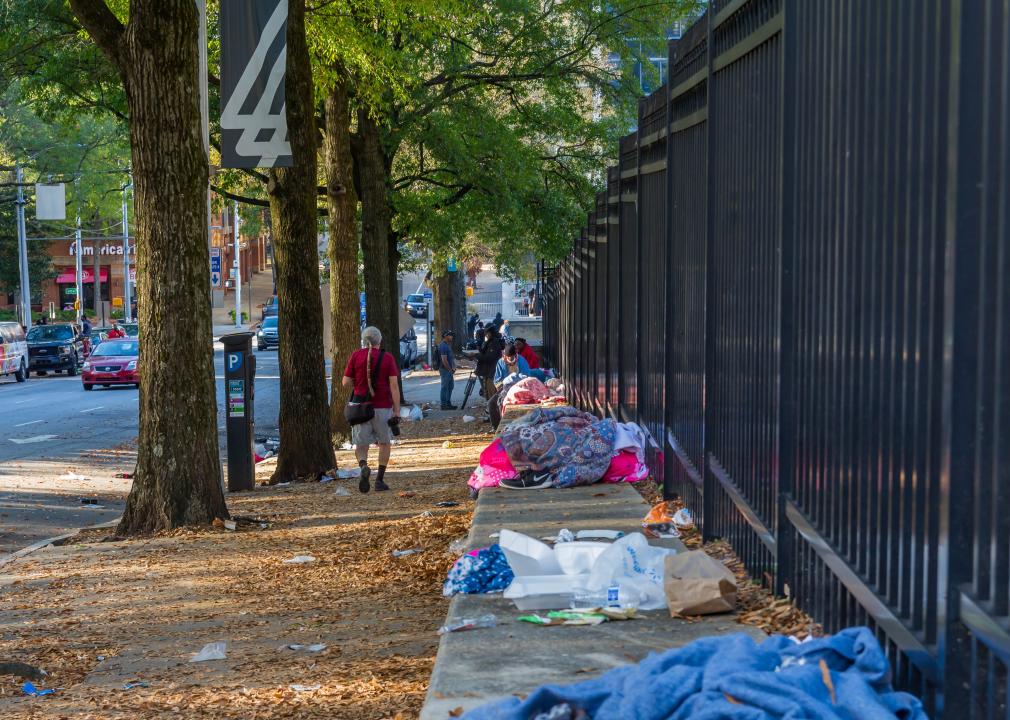
The Brownfowl collection // Shutterstock
#14. Georgia (tie)
- Estimated number of people experiencing homelessness in 2023: 12,294
- Increase since 2022: 15%
In Georgia, efforts to alleviate homelessness have taken the form of funding and work allocated by nonprofit groups, but legislation that strengthens bans on public camping has also been passed. In May 2023, Gov. Brian Kemp signed Senate Bill 62, which requires cities to crack down on tent cities, a measure that advocates say is cruel and ultimately unhelpful in dealing with the root issues of homelessness. The bill also attempts to stop the busing of unhoused people to other cities, which some Georgia advocates say has resulted in more tent cities in certain areas.
Meanwhile, $9 million of government funds have been allocated to building new housing and providing other services across four cities, and communities are attempting to gather better local data on homelessness in order to gauge the extent of the issue.
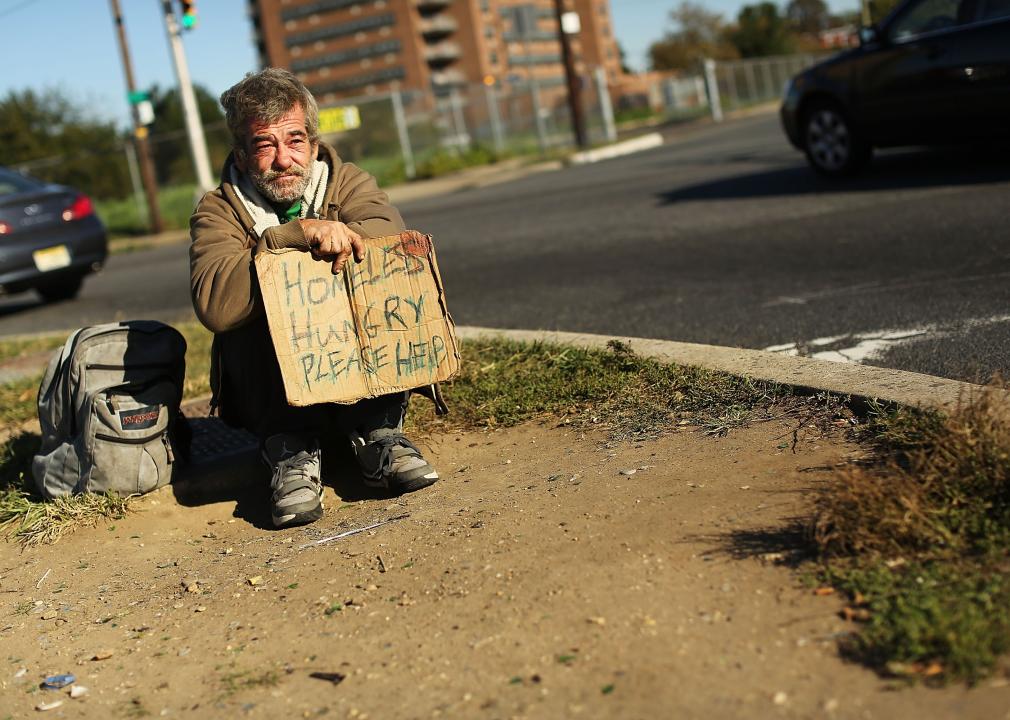
Spencer Platt // Getty Images
#13. New Jersey
- Estimated number of people experiencing homelessness in 2023: 10,264
- Increase since 2022: 17.3%
According to housing advocates, homelessness in New Jersey has been on the rise for the last few years due to skyrocketing housing and rent prices, an affordable housing shortage, and the end of the COVID-era eviction moratorium.
The National Low Income Housing Coalition reported in 2023 that New Jersey was the seventh most expensive state for renters. The state has a shortage of more than 200,000 affordable rental units compared to the number of extremely low-income renter households.
One method being used to combat homelessness in the state is a housing-first approach, which places unhoused people into homes and provides them with resources including medical care, budgeting guidance, food, and more. This approach has proven more effective than others at helping unhoused people with high needs stay housed, according to Emmy Tiderington, a Rutgers University School of Social Work professor.

Jahi Chikwendiu/The Washington Post via Getty Images
#12. Vermont
- Estimated number of people experiencing homelessness in 2023: 3,295
- Increase since 2022: 18.5%
While Vermont has spent hundreds of millions of dollars combatting homelessness over the past two years, rates of people experiencing homelessness have continued to rise in the state, according to a Vermont State Auditor's report in 2022. Despite the funding, fragmented rather than cohesive strategies for targeting the problem are thought to be partially to blame for the continued rise in homelessness.
Besides the factors cited by several other states as contributing to the increase in homelessness—such as housing shortages and rising housing costs—Vermont state officials also pointed to the rise of previously long-term housing being converted into expensive, short-term rental properties as a component of the crisis.
This phenomenon has reduced available long-term housing options, creating low supply and high demand and increasing prices. As of 2023, Vermont has made great strides on that front, sheltering 96% of people experiencing homelessness in the state, the highest rate nationwide.
You may also like: 10 states with the most uninsured veterans—and how the nation compares
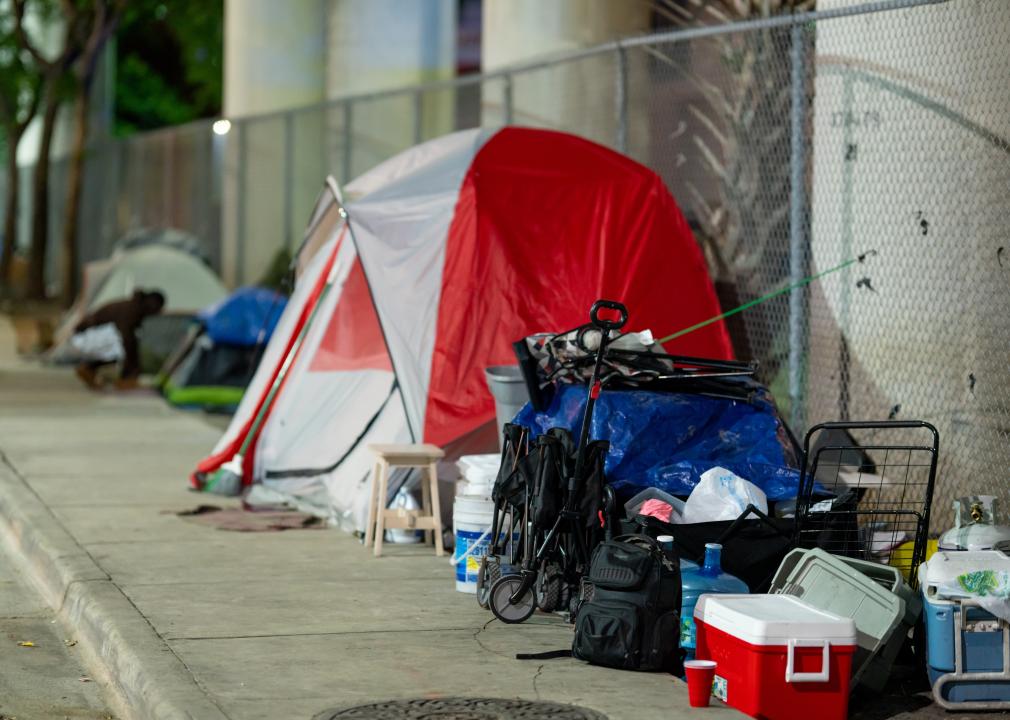
Felix Mizioznikov // Shutterstock
#11. Florida
- Estimated number of people experiencing homelessness in 2023: 30,756
- Increase since 2022: 18.5%
In March 2024, Gov. Ron DeSantis signed into law a measure that criminalizes unhoused people sleeping in public spaces, and creates designated encampment areas overseen by the state if existing shelters are full. These encampments, far away from other facilities, will prohibit the use of alcohol and drugs but do not have expanded funding for mental health services or substance use treatment.
Opponents of the "inhumane" law argue that it is intended to hide unhoused people from view while not dealing with the root causes of homelessness or providing long term solutions.
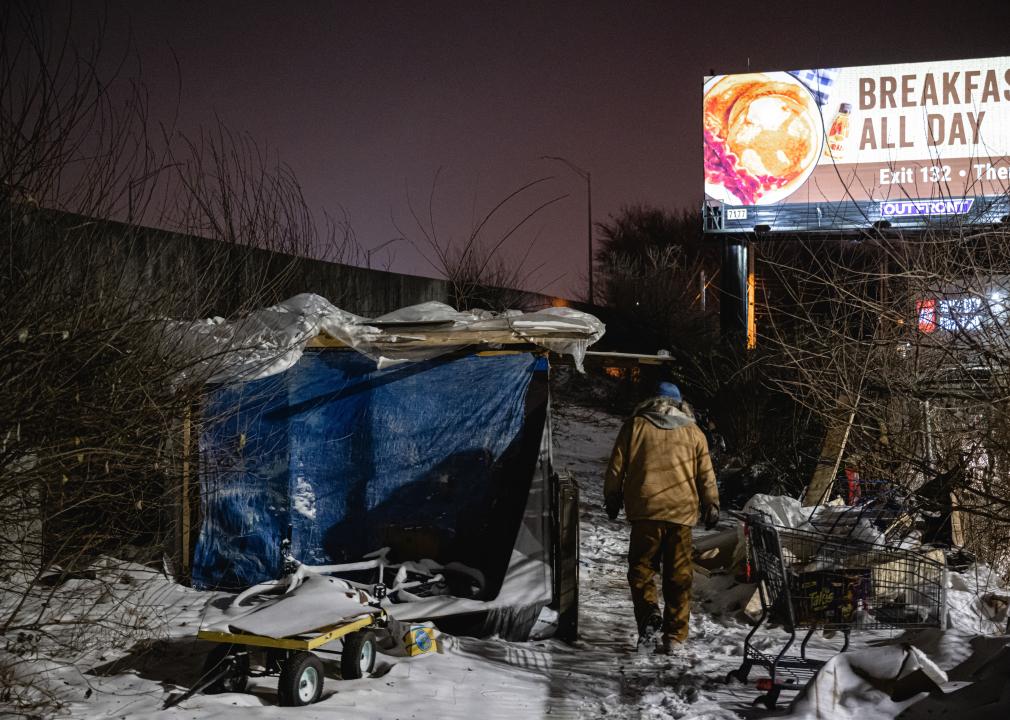
Jon Cherry // Getty Images
#10. Kentucky
- Estimated number of people experiencing homelessness in 2023: 4,766
- Increase since 2022: 19.6%
Similar to Florida's ban on public sleeping, the Kentucky legislature passed a law, nicknamed the Safer Kentucky Act, in April 2024 that prohibits public camping, making it punishable with up to 90 days in jail and a $250 fine. This law goes further, however, decriminalizing the use of deadly force for private citizens who believe an unhoused person is attempting to take their private property.
Both of these measures have been the source of controversy, with over 100 opposing Kentucky-based organizations arguing that the Safer Kentucky Act does more to endanger unhoused people than it does to help them.
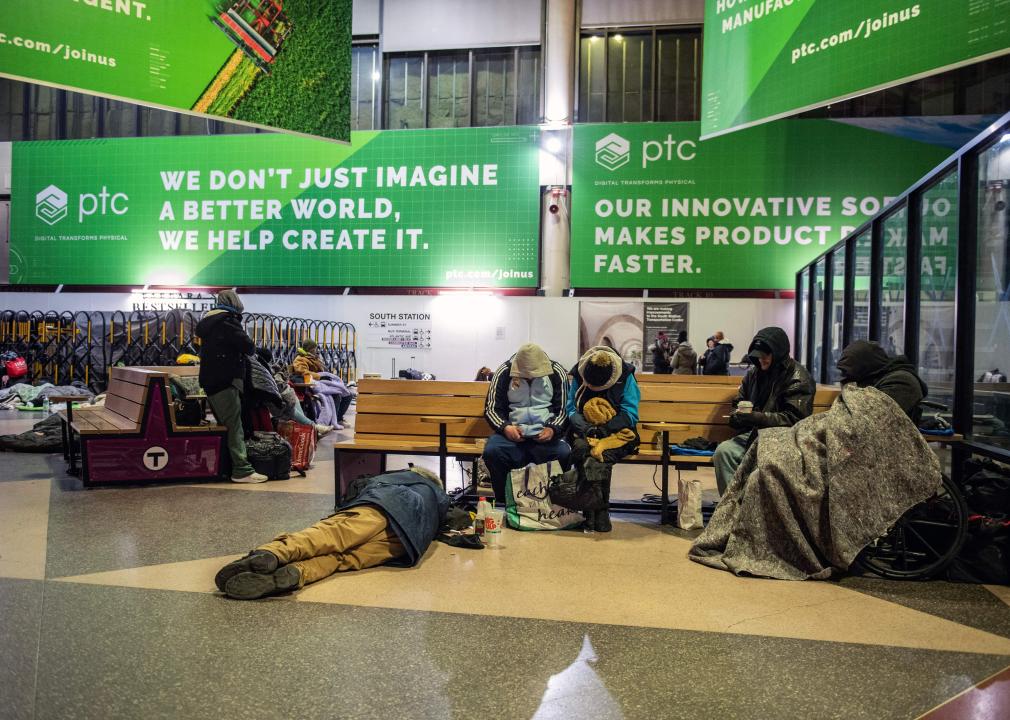
JOSEPH PREZIOSO // Getty Images
#9. Massachusetts
- Estimated number of people experiencing homelessness in 2023: 19,141
- Increase since 2022: 23.4%
Prior to this year, Massachusetts was the only state with a "right to shelter" law that allowed for unhoused families and pregnant people to stay in shelters indefinitely. In May 2024, Gov. Maura Healey signed a new measure into law that limits stays in emergency shelters to nine months, with certain exceptions for people in more precarious positions.
The move came after the number of families staying in state shelters between March 2023 and April 2024 jumped by around 3,500, creating a crowded situation that Healey called "unsustainable." Massachusetts is one of the most expensive states to live in, and while minimum-wage workers earn an average of $780 a month, the average one-bedroom rental unit at fair market rent costs $1,772 per month, making it nearly impossible for low-wage earners to find housing they can afford.
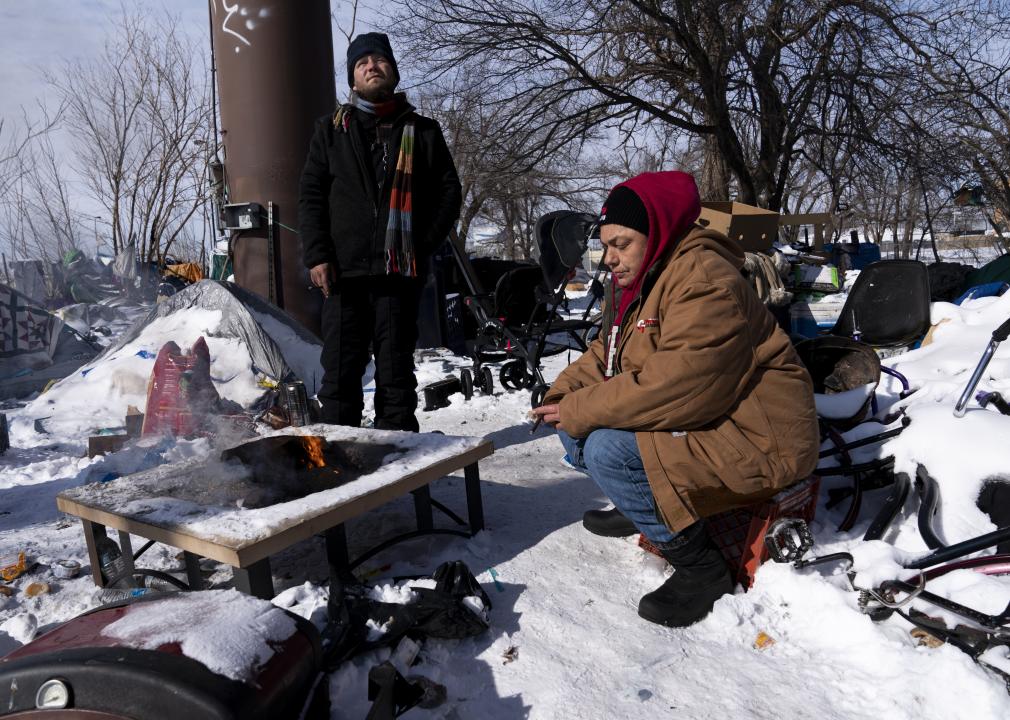
Nick Oxford // Getty Images
#8. Oklahoma
- Estimated number of people experiencing homelessness in 2023: 4,648
- Increase since 2022: 23.8%
Efforts to move people experiencing homelessness from encampments into permanent housing have been taking place over the past few years in Oklahoma's largest cities. In Oklahoma City, for instance, nonprofit organizations have been working to house 1,800 unhoused people. But for unhoused Oklahomans in rural parts of the state, getting connected to services or accessing shelters can be much more difficult—some towns have only daytime shelters, while others have no shelters at all.
In April 2024, Gov. Kevin Stitt signed into law a measure criminalizing sleeping on the streets. The measure specifies that a citation is unlikely "unless the person refuses any assistance offered to them by the arresting officer" in the form of transportation to a shelter.

addkm // Shutterstock
#7. North Dakota
- Estimated number of people experiencing homelessness in 2023: 784
- Increase since 2022: 28.5%
Homelessness in North Dakota is particularly punishing because of the cold temperatures during the fall and winter months. People experiencing homelessness often face the impossible choice of staying warm somewhere and going hungry or venturing out in brutal temperatures in search of food, a Bismarck food bank volunteer told KFYR-TV.
Advocates point to increased evictions, a challenging job market, and a lack of affordable childcare as some of the causes of increased homelessness in the state. The need for shelter beds also far exceeds the number of available beds in some places, particularly in the Fargo-Moorhead area.
You may also like: These 20 cities have seen the highest recent population growth anywhere in the US
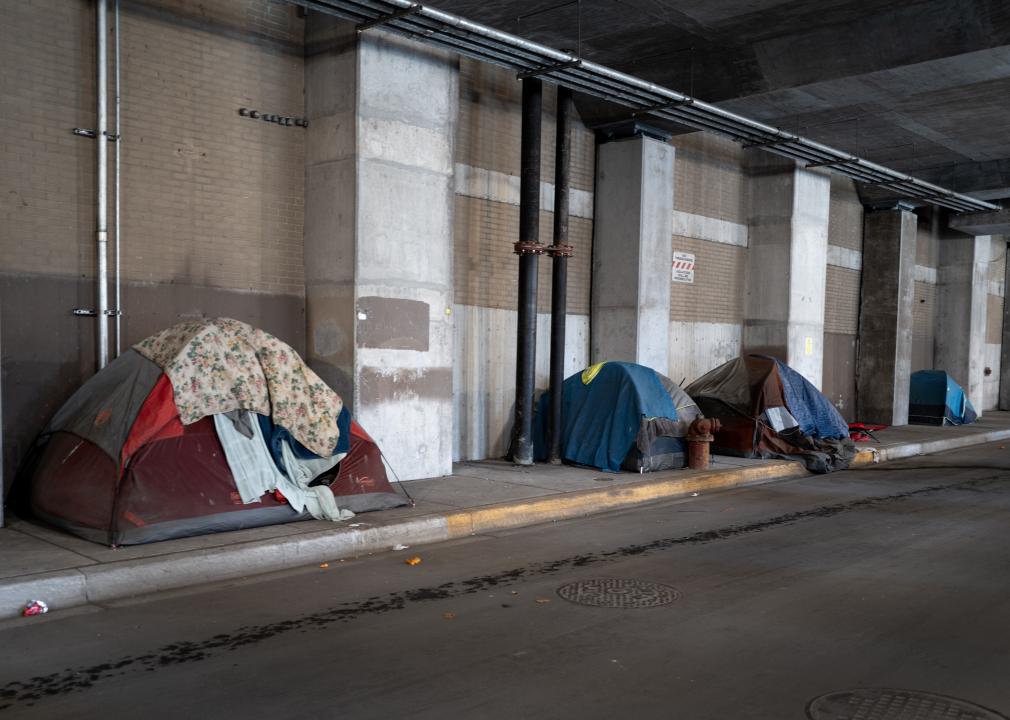
Scott Olson // Getty Images
#6. Illinois
- Estimated number of people experiencing homelessness in 2023: 11,947
- Increase since 2022: 29.7%
In Chicago alone, around 68,440 people experienced homelessness in 2023, a more than 2,800-person increase from the previous year, according to the Chicago Coalition for the Homeless. In an effort to decrease homelessness in the city, Chicago Mayor Brandon Johnson proposed a ballot initiative that would impose a high-end real estate transfer tax to fund homelessness services for $100 million per year, but the measure failed in the March 2024 referendum.
A study published in May 2024 by the University of Illinois Chicago found that Black Illinois residents are eight times more likely to experience homelessness at some point in their lives than white Illinoisans. These findings prompted Illinois Gov. J.B. Pritzker to increase the state's budget for fighting homelessness by $50 million to implement a plan targeting the structural inequalities that contribute to homelessness.
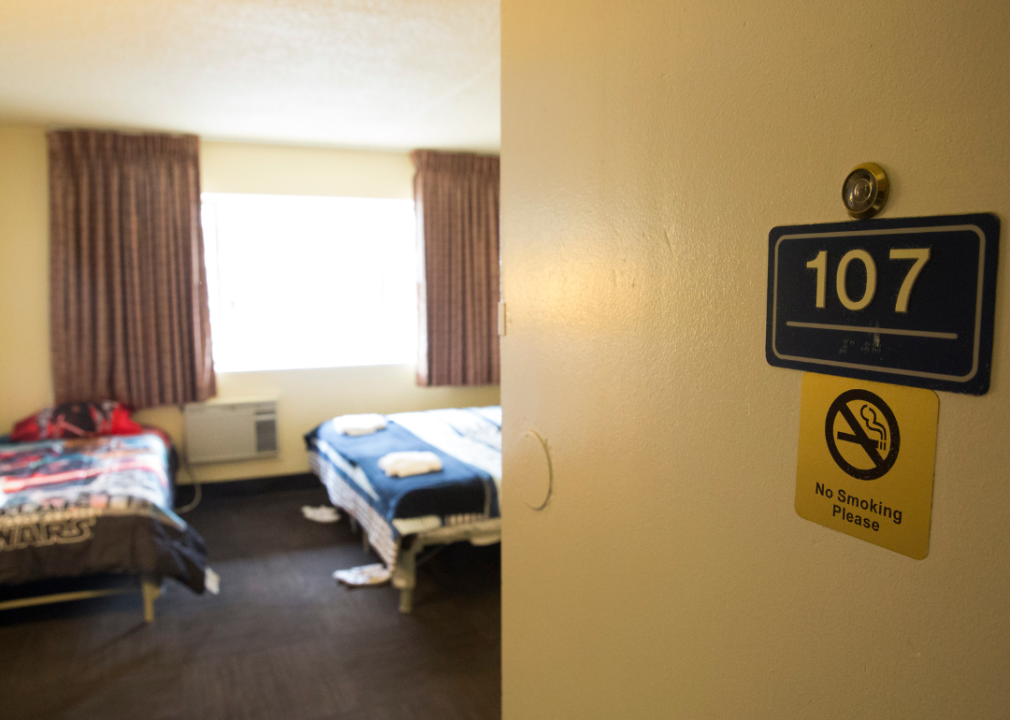
JASON REDMOND/AFP via Getty Images
#5. Montana
- Estimated number of people experiencing homelessness in 2023: 2,178
- Increase since 2022: 37.4%
Montana has the highest rate of chronic homelessness, according to HUD data. Between 2007 and 2023, the state saw numbers jump by 551%, and the lack of shelters could be a factor. Yellowstone Public Radio reported that until 2022, Bozeman, one of Montana's largest cities, did not have a shelter for unhoused people that was open year-round, meaning many people had to stay in encampments or on the streets between April and October, a dangerous venture considering the state's extreme weather.
While officials have laid out plans to invest in affordable housing, the rising cost and lack of housing availability have complicated efforts to mitigate the increasing number of unhoused Montana residents.
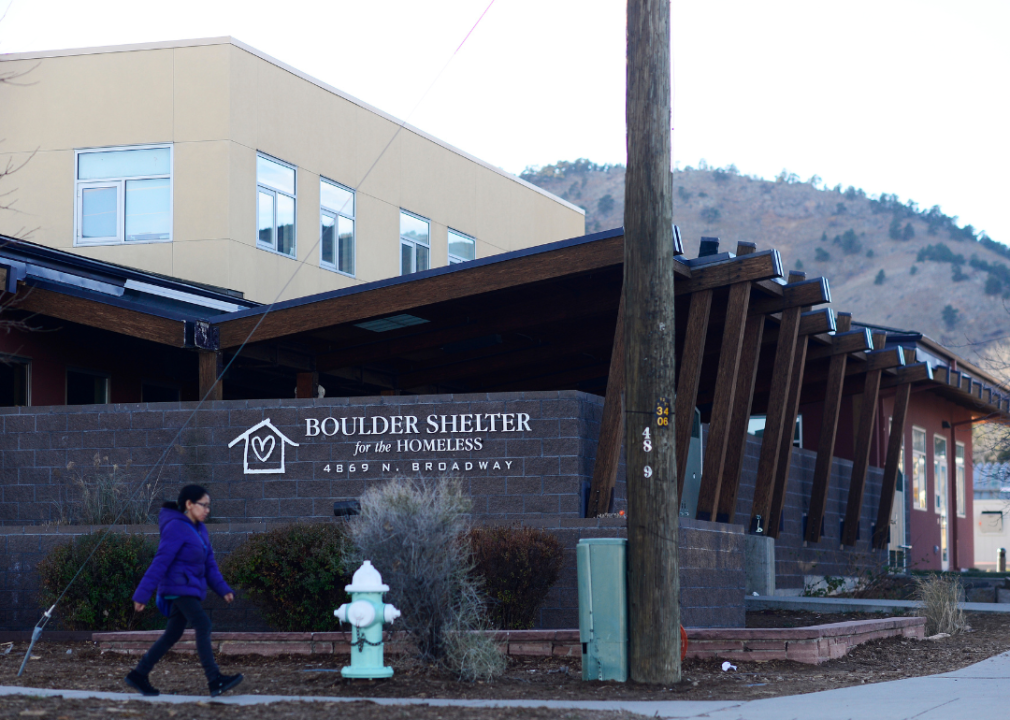
Brent Lewis/The Denver Post via Getty Images
#4. Colorado
- Estimated number of people experiencing homelessness in 2023: 14,439
- Increase since 2022: 38.9%
In 2023, metropolitan Denver ranked #5 among major cities in terms of the largest number of people experiencing homelessness. The rising cost of living in Denver and other parts of the state, coupled with few available homes, have contributed to the crisis.
Denver has piloted some programs meant to mitigate the problem, including the Supportive Housing Social Impact Bond Initiative, a housing-first program that provides people experiencing homelessness with resources like housing, mental health and medical services, and employment assistance. In 2023, Denver Mayor Mike Johnston began relocating 1,000 people from encampment sites in the city directly to housing and he plans to do the same in 2024.
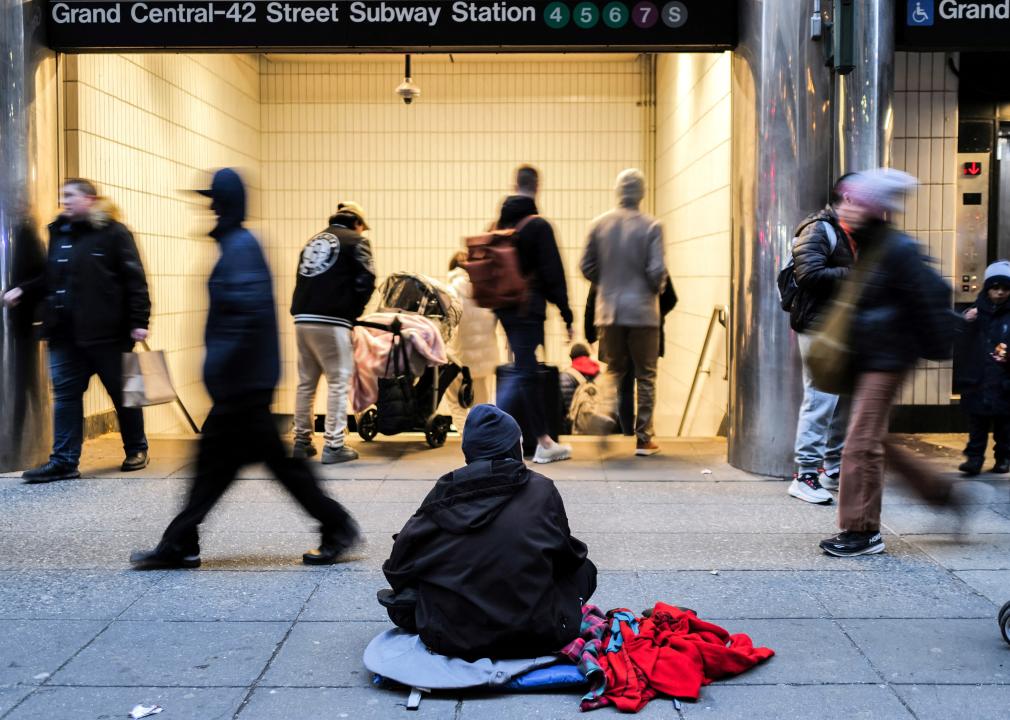
CHARLY TRIBALLEAU // Getty Images
#3. New York
- Estimated number of people experiencing homelessness in 2023: 103,200
- Increase since 2022: 39.1%
Between a lack of affordable housing and a skyrocketing cost of living in both New York City and the rest of the state, New York saw one of the biggest jumps in homelessness in 2023. This does not account for the influx of roughly 90,000 migrants and asylum-seekers who arrived in New York City between 2022 and 2023.
In May 2023, the city passed a "Homeless Bill of Rights," which established people's right to sleep on the streets, along with several other fundamental rights and protections. Though the city has had a "right to shelter" mandate since the '80s, New York City Mayor Eric Adams is challenging it. Adams has also drawn criticism from housing advocates for sending sweeps of encampments and the subway and for implementing a policy that empowers law enforcement to involuntarily hospitalize unhoused people deemed to be in a "psychiatric crisis."
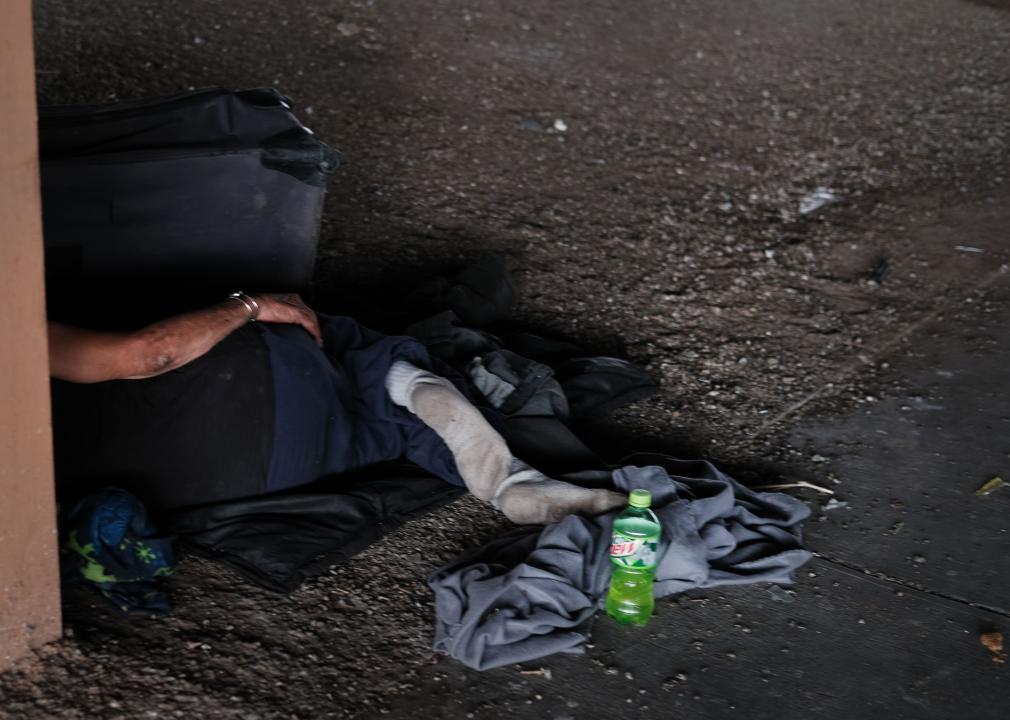
Spencer Platt // Getty Images
#2. New Mexico
- Estimated number of people experiencing homelessness in 2023: 3,842
- Increase since 2022: 50.1%
Extreme heat in New Mexico can create dangerous conditions for unsheltered people experiencing homelessness in the warm months. Without access to reliable cooling sources or air-conditioned spaces, people living in tent encampments can face temperatures of over 140 degrees inside their tents, thanks to the greenhouse effect.
In 2023, a judge ruled that the city of Albuquerque cannot arrest or intimidate people experiencing homelessness, nor can law enforcement confiscate or destroy the property of unhoused people. The ruling came after the ACLU and other legal organizations sued the city on behalf of individuals who had had their belongings seized without notification.
You may also like: America's biggest universal basic mobility experiment is taking place in L.A.
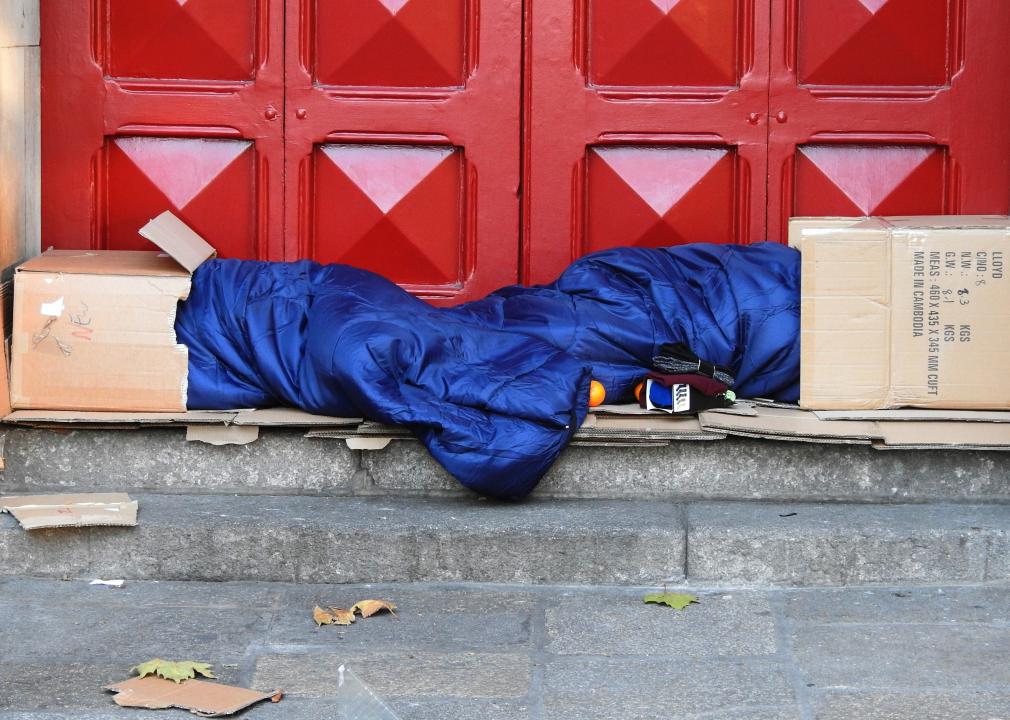
Derick P. Hudson // Shutterstock
#1. New Hampshire
- Estimated number of people experiencing homelessness in 2023: 2,441
- Increase since 2022: 52.1%
The vacancy rate for affordable housing is nearly 0%, according to a 2022 NH Coalition to End Homelessness report. Meanwhile, state-funded shelters are at capacity, which prompted eight New Hampshire mayors to send a letter to the state pleading for more shelter funding. In February 2024, $12.8 million was allocated to local nonprofits and agencies dealing with homelessness to fund services within their specific communities that can be more tailored to unique needs and populations.
Another initiative, the Homeless Prevention Pilot Program, was also introduced and will invest in preventing homelessness before it occurs by tackling some of the root causes of the issue and helping people on the verge of homelessness maintain their housing.
Copy editing by Kristen Wegrzyn. Photo selection by Clarese Moller.